Do you have a question about the Carrier 59SC2D and is the answer not in the manual?
Hazards from improper operation, injury, death, or property damage.
Unit component damage from improper installation, adjustment, or use.
Personal injury from sharp edges on sheet metal parts.
Nuisance smoke/odor complaints from improper installation.
Furnace installation on its back or control compartment facing down is hazardous.
Compliance with NFGC, ANSI/NFPA 90B, and other safety standards.
Adherence to NFGC, NFPA 90B, and local codes for installation.
Compliance with NFGC, CAN/CSA-B149.1, and national plumbing codes.
Adherence to NEC NFPA 70 and Canadian Electrical Code CSA C22.1.
Unit component damage from electrostatic discharge during handling.
Corrosive air contamination causing heat exchanger corrosion and furnace failure.
Installation requirements for electrical protection, water, and servicing space.
Premature furnace failure due to improper use or installation.
Overview of air requirements for combustion and ventilation.
No special provisions for combustion air in direct vent systems.
Adequate combustion air is required for non-direct vent systems.
Risk of CO poisoning from negative pressure conditions created by exhaust fans.
Instructions for relocating the condensate trap in upflow installations.
Relocation of the condensate trap for downflow orientation.
Relocation of condensate trap for horizontal right installation.
Relocation of condensate trap for horizontal left installation.
Risk of burst water pipes and property damage from condensate issues.
Routing the condensate drain from the trap through the casing.
Connecting the drain elbow to the outlet stub on the drain trap.
Personal injury from sharp edges during drain installation.
Specific considerations for installing furnace in upflow orientation.
Connecting return air duct to furnace bottom opening.
Connecting supply air duct to furnace outlet flanges.
Never connect return-air ducts to the back of the furnace.
Pitching the furnace forward for proper condensate drainage.
Hazards from improper installation orientation or control compartment placement.
Local codes may require a drain pan for attic installations.
Consult local officials for ductwork design and performance requirements.
Duct system design based on national standards and local codes.
Proper filter selection and duct sizing for HVAC systems.
Methods for reducing noise transmission in metal and fibrous ductwork.
Hazards from improper gas line purging, testing, or connections.
Furnace damage from incorrect pipe connection or misalignment.
Specific requirements for licensed installers, connector length, and valve types.
Hazards from improper servicing of electrical components.
Risk of shock if blower door switch is bypassed or not closed.
Proper connection and grounding of the 115-v power supply.
Do not connect aluminum wire between disconnect switch and furnace.
Compliance with CSA B149 code, ULC S636, and specific pipe/fitting/cement requirements.
Risk of CO poisoning from improper venting configuration or appliance operation.
Nuisance smoke/odor complaints from improper installation.
Intermittent unit operation or performance dissatisfaction due to limit switch issues.
Risk of CO entry into structure if condensate trap is not properly primed.
Hazards from purging gas lines into combustion chamber or using open flame for leak tests.
Hazards from performing maintenance without proper knowledge or tools.
Improper wiring or servicing can cause dangerous operation or injury.
Hazards from improper servicing, lockout tag violations, or wiring errors.
Understanding switch break points and wiring standards.
Step-by-step process for furnace operation during heating mode.
Operation sequence for cooling mode, including blower and thermostat signals.
Furnace blower operation when thermostat is set for continuous fan.
Furnace control logic for heat pump integration and defrost cycles.
Hazards from improper installation, adjustment, or use of replacement parts.
Hazards from improper operation, injury, death, or property damage.
Unit component damage from improper installation, adjustment, or use.
Personal injury from sharp edges on sheet metal parts.
Nuisance smoke/odor complaints from improper installation.
Furnace installation on its back or control compartment facing down is hazardous.
Compliance with NFGC, ANSI/NFPA 90B, and other safety standards.
Adherence to NFGC, NFPA 90B, and local codes for installation.
Compliance with NFGC, CAN/CSA-B149.1, and national plumbing codes.
Adherence to NEC NFPA 70 and Canadian Electrical Code CSA C22.1.
Unit component damage from electrostatic discharge during handling.
Corrosive air contamination causing heat exchanger corrosion and furnace failure.
Installation requirements for electrical protection, water, and servicing space.
Premature furnace failure due to improper use or installation.
Overview of air requirements for combustion and ventilation.
No special provisions for combustion air in direct vent systems.
Adequate combustion air is required for non-direct vent systems.
Risk of CO poisoning from negative pressure conditions created by exhaust fans.
Instructions for relocating the condensate trap in upflow installations.
Relocation of the condensate trap for downflow orientation.
Relocation of condensate trap for horizontal right installation.
Relocation of condensate trap for horizontal left installation.
Risk of burst water pipes and property damage from condensate issues.
Routing the condensate drain from the trap through the casing.
Connecting the drain elbow to the outlet stub on the drain trap.
Personal injury from sharp edges during drain installation.
Specific considerations for installing furnace in upflow orientation.
Connecting return air duct to furnace bottom opening.
Connecting supply air duct to furnace outlet flanges.
Never connect return-air ducts to the back of the furnace.
Pitching the furnace forward for proper condensate drainage.
Hazards from improper installation orientation or control compartment placement.
Local codes may require a drain pan for attic installations.
Consult local officials for ductwork design and performance requirements.
Duct system design based on national standards and local codes.
Proper filter selection and duct sizing for HVAC systems.
Methods for reducing noise transmission in metal and fibrous ductwork.
Hazards from improper gas line purging, testing, or connections.
Furnace damage from incorrect pipe connection or misalignment.
Specific requirements for licensed installers, connector length, and valve types.
Hazards from improper servicing of electrical components.
Risk of shock if blower door switch is bypassed or not closed.
Proper connection and grounding of the 115-v power supply.
Do not connect aluminum wire between disconnect switch and furnace.
Compliance with CSA B149 code, ULC S636, and specific pipe/fitting/cement requirements.
Risk of CO poisoning from improper venting configuration or appliance operation.
Nuisance smoke/odor complaints from improper installation.
Intermittent unit operation or performance dissatisfaction due to limit switch issues.
Risk of CO entry into structure if condensate trap is not properly primed.
Hazards from purging gas lines into combustion chamber or using open flame for leak tests.
Hazards from performing maintenance without proper knowledge or tools.
Improper wiring or servicing can cause dangerous operation or injury.
Hazards from improper servicing, lockout tag violations, or wiring errors.
Understanding switch break points and wiring standards.
Step-by-step process for furnace operation during heating mode.
Operation sequence for cooling mode, including blower and thermostat signals.
Furnace blower operation when thermostat is set for continuous fan.
Furnace control logic for heat pump integration and defrost cycles.
Hazards from improper installation, adjustment, or use of replacement parts.
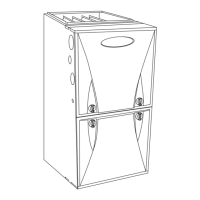
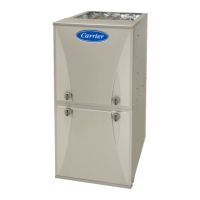
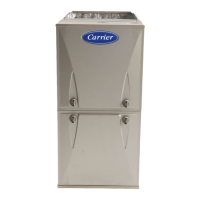
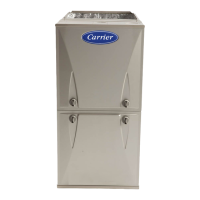
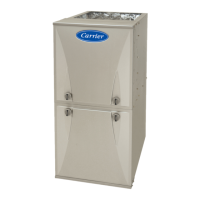
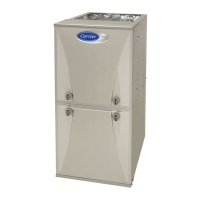
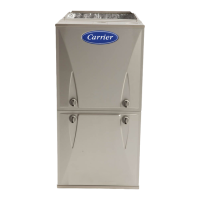





